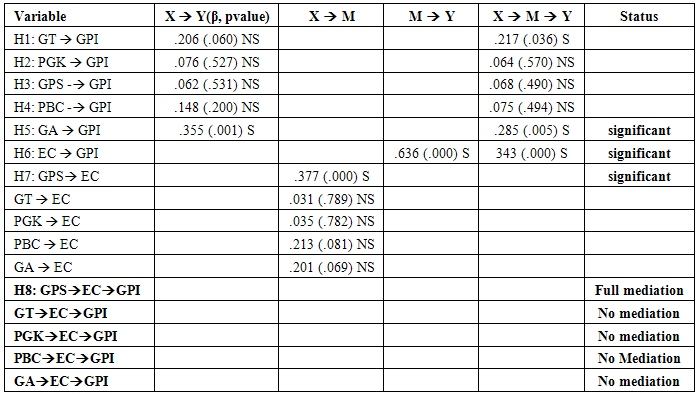-
Paper Information
- Next Paper
- Previous Paper
- Paper Submission
-
Journal Information
- About This Journal
- Editorial Board
- Current Issue
- Archive
- Author Guidelines
- Contact Us
American Journal of Economics
p-ISSN: 2166-4951 e-ISSN: 2166-496X
2015; 5(2): 291-302
doi:10.5923/c.economics.201501.38
Predictors of Green Purchase Intention in Nigeria: The Mediating Role of Environmental Consciousness
Victoria Masi Haruna Karatu 1, Nik Kamariah Nik Mat 2
1College of Business, Universiti Utara Malaysia
2OYA-Graduate School of Business, Universiti Utara Malaysia
Correspondence to: Victoria Masi Haruna Karatu , College of Business, Universiti Utara Malaysia.
| Email: |  |
Copyright © 2015 Scientific & Academic Publishing. All Rights Reserved.
In spite of global awareness towards the environment and green marketing, evidences in Nigeria revealed that only 5% of the population is engaged in green purchase behavior. Nigerians are also facing problems such as inadequate green knowledge, lack of environmental consciousness, lack of government control, high price of green product and distrust towards green products. Hence, the objectives of this study are two-folds: (1) to examine the direct predictors (perceived green knowledge, perceived behavior control, green availability, green trust, and green price sensitivity) of green purchase intention and (2) to establish the mediating effect of environmental consciousness on the relationship between the above mentioned predictors and green purchase intention. This study uses quantitative method by distributing 150 questionnaires to lecturers in Nigerian universities. 102 datasets were returned representing 68 percent response rate. The screened data were analyzed using regression. The findings indicate that green availability is directly and significantly related to green purchase intention (β=.355, p<.001), while green price sensitivity is directly and significantly related to environmental consciousness (β=.377, p<.000). The relationship between green price sensitivity and green purchase intention is fully mediated by environmental consciousness. In conclusion, green purchase can be increased when there is abundance of green products. Nigerians also believe that high priced green products will increase their awareness towards environmental consciousness. Environmental consciousness plays a very significant mediating role in influencing the relationship between green price and green purchase intention.
Keywords: Environmental Consciousness, Green Availability Green Trust, Green Price Sensitivity, Perceived Green Knowledge, Green Purchase Intention
Cite this paper: Victoria Masi Haruna Karatu , Nik Kamariah Nik Mat , Predictors of Green Purchase Intention in Nigeria: The Mediating Role of Environmental Consciousness, American Journal of Economics, Vol. 5 No. 2, 2015, pp. 291-302. doi: 10.5923/c.economics.201501.38.
Article Outline
1. Introduction
- In this environmentally conscious era it is pertinent to understand issues which spur consumers to adapt to environmentally safe behaviour. The global warming has brought challenges in the way people live. This somehow has impacted consumers’ purchasing behaviour in most regions of the world. Consequently, the trend has led consumers to make environmental considerations in choices they make on daily purchase of products] (Barbe, Taylor & Strick, 2009) Consumers became increasingly apprehensive and aware of their importance in the society and the role they need to play as their environmentally propelled action and inaction will certainly affect their environment and well-being in the long run. This triggered the demand for environmentally safe products (Rashid, 2009; Chen, 2010; Ali and Ahmad, 2012). This continued to grow especially in developed countries (Greendex, 2012, Synovate survey, 2011). Natural (Green) Marketing reported over 200 USD billion market of lifestyle of Health and Sustainability (LOHAS) rose by 100% in 2010 and expected to rise four times bigger by 2015 (Widger, 2007). Also, Global Baby organic food market grows by 5% yearly. (Quick Pulse survey, 2011)As environmental consciousness became stronger, the quest for green products continued to soar high, worldwide the consumers began to give considerations to the price of green products and are willing to pay extra for them (Bazoche, Deola & Soler, 2008) and how these products which they believe can improve the quality of their lives can be made available. However, this is not as pronounced in a developing nation like Nigeria as little is known about “green”. Even though the green agenda was launched since 1990, Nigeria still lagged behind on green issues as indicated by the low percentage (5%) of green product purchase (Quick Pulse survey, 2011; Olamuyi, 2012). This shows that there is a low level of green awareness among Nigerian consumers. Furthermore, there seems to be the absence of environmental consciousness among her citizens which is depicted by poor waste management which mars the physical surroundings of streets, business environments and worsening pollution scenario. Aside this, although studies have been conducted in different context, especially in developed countries with different predictors of green purchase intention; these were however not examined in the Nigerian context. Based on the assertion that variations exist in cultural, socio- demographic, geographical setting and complexity of consumer behavior, and also differences on the basis of market forces which can significantly impact demand and purchase behaviour towards environmental friendly products (Elhan & Nabsiah, 2011; Ottman, 1992; Peattie, 1992), the need to have this variables tested in Nigeria becomes fundamental or inevitableAdditionally, the combination of these variables, (perceived green knowledge, perceived behavioural control, green price sensitivity, green availability, green trust and environmental consciousness) is rare. Besides, environmental consciousness was scarcely studied (Sharma & Bansal, 2013) and also used as a mediating variable in green purchase intention studies as review of extant literature did not show any so far.
2. Problem Statement
- Nigerian as a nation is challenged by the following issues which have been addressed as research problems in this study. They are inadequate green knowledge, lack of environmental consciousness, lack of government control, high price of green and distrust towards green products.
3. Objectives
- Based on the above stated problems and extensive review of literature, the objectives of this study are categorized into two-folds: (1) To examine the direct predictors (perceived green knowledge, perceived behavior control, green availability, green trust, and green price sensitivity) of green purchase intention and (2) To establish the mediating effect of environmental consciousness on the relationship between the above mentioned predictors and green purchase intention.
4. Review of Literature
4.1. Green Purchase Intention
- Studies on green purchase intention showed that intention is an influential predictor of green purchase behavior because purchase intention strongly affects the likelihood of decision to buy the product (Chen, 2010). Moreover, the theory of planned behavior by Ajzen (1999) explained that green purchase intention is a crucial element in ascertaining the real or actual buying behavior of an individual. Past studies revealed that consumers with high level of concern for the environment and are not skeptical about green products tend to portray positive attitude, norms and high degree of perceived behavioral controls. (Albayrak, Aksoy & Caber, 2013). In affirmation to this, researchers who examined this variable have proved that it exerts strong and significant influence on actual purchase of green; this buttressed the fact that someone with positive intention is likely to go for the green product when compared with a person with low intentions (Ali, Khan, Ahmad & Shahzad, 2011).This notwithstanding, the outcome of these studies cannot be globally generalized due to cultural, socio-economic, psychological and other factors which vary from region to region (Rahbar & Wahid, 2011). Kotler (2004) also opined that demands and attitudes of consumers towards green products cannot be the same globally because of differences in culture and market factors. Equally significant here is the level of consciousness and awareness about environmental problem; the extent to which it has been stirred up in different parts of the globe determines the level of intention conceived by the individual or the people in such community. Intention thus, is the main point/pivot on which behavior revolves. Ajzen (1991) further stated that it captures the motivational factors which impacts behavior.
4.2. Green Trust and Green Purchase Intention
- Trust is one element that is fundamental in business and sustainable development and enhances long-term relationship or loyalty between the owners of the business and their customers or client. The sets of beliefs, desire and accumulated assumptions over time which is directed towards a brand explains what trust stands for (Swean & Chumpitaz, 2008). Chen and Chang (2012) allied their definition of trust from this point of view by saying that it is the willingness to rely on one object or person based on the belief or anticipation resulting from credibility, benevolence and ability about the environmental performance. These three ingredients (credibility, benevolence and ability) affect the formation of trust.Many authors in the past acknowledged that green trust is a strong determinant of purchase intention (Rizwan, Hassan & Javeed, 2013; Terenggang, Supit & Utami, 2013; Porpratana, Lockard & Ngamkroechjoti, 2013; Chen & Chang, 2012; Gupta & Dash, 2012; Paspalis, 2011) These authors came up with a positive outcome which implied that significant relationship existed between trust and green purchase intention even though their studies were from different background. On the whole, the results of the authors proved that a positive influence of trust on green purchase intention existed. Additionally, (Terrenggana, et al, 2013; Chen & Chang, 2012; Gupta & Dash, 2012; Paspalis, 2011). Contrariwise, the study of Ng and Paladino (2009) suggested that a negative relationship existed between perceived brand trust and the intention to buy green mobile phone as the hypothesis was not supported. Thus, this study formulates the following hypothesis:H1: Green Trust is positively related to green purchase intention
4.3. Perceived Green Knowledge and Green Purchase Intention
- Perceived green knowledge has been viewed as the ability of the individual consumer to define or identify certain symbols, concepts and behavior which are connected to environmental problems. It is also defined as how much the consumer feels he or she knows about environmental or green issues (Chan, 1999). Basically, consumer’s green knowledge will affect to a great extent what they do and what they purchase (Elles, 1994).Putting the Nigeria situation aside in the meantime, previous studies have investigated green knowledge by surrogating the term with environmental awareness, environmental knowledge and ecological knowledge. (Wu, Huang & Teng, 2013; Azizan & Suki, 2013; Rizwan, Asif, et al, 2013; Shamsollahi, Chong & Nahid, 2013; Mei, Ling & Piew, 2012; Sakthirama & Venkatran, 2012; Aman, Harun & Hussein, 2012; Ali & Ahmad, 2012; Feng, 2011) however, all outcomes were significant.Supporting their findings (Azizan & Suki, 2013; Aman et al 2012) put forward that understanding the issues which relate to environmental problems is important in producing a significant impact on consumer’s purchase intention; furthermore, that when there is increased in knowledge, the consumer becomes more informed and knowledgeable and this raises high the possibility of the purchase intention (Shamsollah, et al, 2013; Aman et al, 2012). In addition, Sakthirama and Venkatran, (2012) suggested that knowledge and familiarity being significant factors which impacts purchase intention should be considered in the marketing of organic foods. Following Feng’s (2011) findings, the author explained that since ecological knowledge influenced attitude, it was in turn significant in affecting the purchase intention for the green water saving product. However, Ail and Ahmad (2012) stated that though environmental knowledge was significant it had the lowest value amongst the other variables tested; this they attributed to the low level of environmental knowledge among the sample examined.H2: Perceived green knowledge is positively related to green purchase intention
4.4. Perceived Behavioral Control and Green Purchase Intention
- The concept of perceived behavioral control has been referred to as the degree of controlling one’ own behavior (Numraktrakul, et al, 2011) while Tan (2013) asserted that it reflects the individual’s acumen of the effortlessness or difficulty of performing a given behavior. Depicting the extent of the relationship which exist between perceived behavioral control and green purchase, prior studies of (Tan, 2013; Sadati & Mohammed, 2012; Lien, Huang & Chang, 2012; 2012; Kim & Chung 2011; Wu & Teng, 2011) supported the role PBC plays as a significant factor in predicting behavioral intentions. Moreover, Tan (2013) posited that consumers are likely to purchase green homes with available resources and opportunities, this he concluded from the result of the 252 potential Malaysian green home buyers. Likewise, Sadati and Mohammed (2012) confirmed that price which is financial resource available to the consumer can enhance green purchase intention; similarly, Lien, Ling, Yeow, Hasan and Arif, (2011) emphasized on education of consumers on green consumption. In the same vein, (Rizwan, et al (2013) laid hold on awareness, income and education for outcome of their findings. In the case of (Mahesh & Ganapath, 2012; Kim & Chung 2011) they identified environmental consciousness and appearance consciousness (Kim & Chung; 2011) while concern for food safety, protection of the environment were seen as supporting factors which affect their purchase intention. On the reverse, Ng and Paladino (2009) declared a negative association between perceived behavioral control and purchase intention of the 175 undergraduates; explaining further, they attributed this to the lack of information on the product and its availability. The reviewed literatures all laid part to congruence except one study which had a negative result (Ng & Paladino, 2009). Based on this therefore, the following hypothesis is stated.H3: Perceived Behavioral Control is positively related to green purchase intention
4.5. Green Price Sensitivity and Green Purchase Intention
- Price denotes the monetary value fix on a product in the light of a company’s policy on pricing strategy in connection to the environment and creates a perfect match between revenue and profit. The American Marketing Association defined price as the formal ratio that indicates the amount of money needed to acquire a given quantity of goods or service (Marketingpower.com). Price premium according to Numraktrakul, et al (2011) is the additional amount paid for product instead of the usual price; this could indicate consumer’s willingness to pay for green product. On the other hand, Zhen and Mansori (2012) asserted that consumer’s attitude and perception are correlated with their willingness to purchase.There has been negative perceptions of green product prices; consumers complain of high prices of green products (D’Souza, 2007; Grail research, 2010) affirmed that consumers have the notion that green products are highly priced in comparison to conventional ones. Though concern for the environment will induce purchase decision, high price can inhibit the actual purchase because consumers are price sensitive (quick pulse survey, 2011; synovate survey, 2012).Even so, the discussions on the studies of previous researchers have thrown light on the relationship between green price and purchase intention. The studies carried out by (Ansar, 2013; Lee, Ling, Yeow & Hasan, 2011; Ali & Ahmad, 2012; Zhen & Mansori, 2012). Mansor, Yahaya, Nizam & Aman; 2011 Menahem, Boxer & Rekettye, 2010) confirmed that green price significantly influenced purchase intention of consumers. Furthermore, Ansar (2013) in his investigation on how green marketing impacts consumer purchase intention in Pakistan on 384 consumers suggested that environmentally conscious consumers still go for environmentally safe products even when it is expensive. While in another opinion, it was established that if businesses can offer same price and quality for green products as for the conventional ones, consumers who have positive feeling towards protecting the environment will have high purchase intention for green products (Lee, et al, 2011; Ali & Ahmad, 2012).On the contrary (Zhen & Mansori, 2012; Mansor, Yahaya, Nizam & Aman, 2011) explained that high price will reduce purchase intention for organic food while low price will push it up (Zhen & Mansori,2012) and likewise (Mansor, et al, 2011) claimed that consumers would want to spend on green automobiles only if the prices are reasonable and affordable. In the same manner, Menahem, Boxer and Rekettye (2010) agreed that price is positively associated with purchase intention for green sheltered homes; arguing this out, they opined that the stronger the intention, the higher the willingness to pay.This notwithstanding, Ng and Paladino (2009) did not find support in the studies discussed earlier; agitating that price does not inhibit the formation of green purchase intention especially where subjective norm prevails over the subjects in the investigation as the case of the Australian adolescents which were studied.H4: Green price sensitivity is positively related to green purchase intention
4.6. Green Availability and Green Purchase Intention
- Place comprise of the channels, coverage, assortments, location and inventory and also the process of moving finished and semi-finished goods to the customers. (Kotler & Keller, 2009) Putting this more succinctly is making the product available or accessible. Consumer’s perceived green availability is how easily he/she thinks the product can be obtained (Zhen & Mansori, 2012; Olivova, 2011; Tarkieanen, & Sundqvist, 2005). Non-availability of green products can negatively affect the intention to buy especially if there was initial motivation for the product (Lodofos, 2008). In a confirmation to this, Vermier and Verbeke, (2004) forwarded that even if there was the intention to purchase a product and the consumer discovers that the product is out of store, he/she becomes discouraged and the behavior becomes difficult to perform; translating intention into actual purchase becomes impossible based on the mere fact that accessibility is difficult.Most often, the availability of products in designated channels and adequate information on location can enhance consumes effort to locate and make purchases or be forced to change outlets or switch to other brands (Bhate & Lawler, 1997).In order to determine the impact of this variable on purchase intention, the findings in the few literatures reviewed presented insignificant results (Ragavan & Mageh, 2013; Zhen & Mansori, 2012; Ahmad & Juhdi, 2010). Expounding on their result, the authors declared claimed that availability was not a strong factor to affect purchase intention in Malaysia (Zhen & Mansori, 2012; Ahmad & Juhdi, 2010) Similarly, Ragavan and Mageh (2013) explained that the young female consumers are very much aware of the high quality of organic food products, its benefit to their health and safety in consumption so they look for the products because they are well informed, thus the insignificant relationship in the context of study. The analyses of the aforesaid studies which were done by the same analysis method (regressions) all laid paths to congruence on insignificant association with green purchase intention; these results cannot be generalized anyway because of the differences in cultural and social-economic factors in backgrounds thus the need for this variable to be tested in Nigeria. H5: Green Availability is positively related to green purchase intention
4.7. Environmental Consciousness and Green Purchase Intention
- Environmental consciousness as one of the variables selected for this study has been considered by different authors to indicate the level of alertness consumers or a society have towards environmental problems. Zelezny and Schultz (2000) for instance saw it as the element of belief system which refers to specific emotional factors that affect their inclination to partake in pro-environmental behavior. Lending support to this definition, Schleglmilch, Bohlen and Diamantopoulos (1996) proposed that it is a multidimensional concept that comprises of cognitive and affect components. Furthermore, environmental consciousness can be manifested through certain behavior (Sharma & Bansal, 2013). Subsequently, Numrakutrakul, Ngarmyarn and Panichpathom, (2011) is also of the opinion that consumers will be spurred to purchase environmentally safe products if they are convinced that the product is essential in curbing environmental problems. one’s everyday life style activities (H’Mida, 2009; Kim & Han, 2010).Environmental consciousness directs the individual in making purchase decision; this consciousness about the environment can lead consumers or nations to consider greener decision in their purchases (Peattie, 2001). Accordingly, giving strength to the above opinions, environmentally conscious consumers demonstrate their awareness of green impacts associated with a product or service and their desire to lessen those effects through their purchase choices (Schwepker and Cornwell, 1991). Such consumers sometimes as opined by Chen and Chai (2010) usually through their premeditated actions, boycott manufacturers and retailers who are not green conscious and keenly support the protection of the planet through their anti-consumption attitude. This construct however though sometimes referred to as environmentally significant behavior, environmentally friendly behavior and environmentally responsible behavior (Urban & Zvenrinova, 2009) has limited studies in which its relationship with green purchase intention was tested. In the study by Sharma and Bansal (2013) they confirmed that lifestyle-based investigation of environmentally conscious consumers is an area which is widely not explored, not only in green but in none-green area. The review of extant literature indicated a hand full of studies (Kim & Chang, 2011; Numraktrakul et al, 2011; Kim & Han, 2010). Considering these studies, their findings revealed that environmental consciousness is a positive predictor of green purchase intention. The study of Numraktrakul et al, (2011) investigated what factors affected green housing purchase using six variables in direct relationship. They found that a significant relationship between environmental consciousness and green purchase intention though it had the least value compared to the other constructs. They attributed the reason for this outcome to the fact that green home concept is not a widely known concept and that Thai consumers are still uncertain about the demand for it.Furthermore, Kim and Han (2010) explained that environmental consciousness positively influenced the intention to pay conventional price for green hotel based on his survey of the 389 hotel customers in US. Buttressing their finding, they declared that individual’s sensitivity to the different environmental problems and their perceived usefulness in environmentally friendly activities aimed at curbing the problems can influence proactive environmentally conscious behaviors in their everyday life.H6: Environmental consciousness is positively related to green purchase intention
4.8. Mediation of EC
- Even though Kim and Chang (2011) examined environmental consciousness in their study, it was investigated as a dimension of consumer values and was mediated by consumer attitude towards buying organic body/hair care product. A positive relationship equally ensued portraying the fact that environmental consciousness significantly affected attitude and attitude was found to positively influence green purchase intention.The outcomes from the two studies were found to be positive in spite of the fact that they were done in different settings with different population and method of analysis. Thus following the outcome of these studies, these hypotheses were formulatedH7: Green price sensitivity positively relates to environmental consciousnessH8: Environmental consciousness mediates the relationship between green price sensitivity and GPI
5. Proposed Research Model
- Based on the literature review above, we proposed a research framework for this study as in Figure 1.
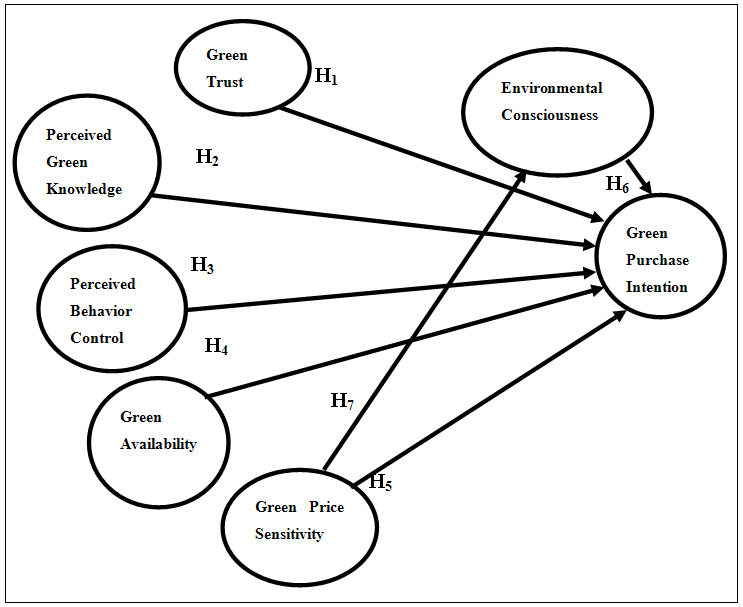 | Figure 1. Research Framework |
6. Methodology
- Research design uses the survey method for collection of data due to its credibility to gather a vast range of appropriate facts which can be depended on upon as respondents have limited options stated in the questionnaire (Rindfleisch, Malter, Ganesan & Moorman, 2008). The quantitative method was adopted and 150 questionnaires were distributed to lecturers in Nigerian universities. 102 datasets were returned representing 68 percent response rate. The screened data were analyzed using regression. The constructs’ measurement used comprises of five independent variables which are Perceived Green Knowledge (PGK, 12 item), Green Availability (GAV, 6item), Green Price Sensitivity (GPS, 9item), Perceived Behavioural Control (PBC, item) and Green Trust (GT, 6item). The study included one mediating variable which is Environmental Consciousness (EC, 6item), and one dependent variable, Green Purchase Intention (GPI, 6item). Measurement scale is a fundamental tool when it comes to deciding on a particular statistical test. Constructs can be measured and conveyed in different scales, but the most frequently used measurement scale in social and behavioural science studies is the Likert scale, (Nanna & Sawilowsky, 1998). Mostly, Likert-type scale is preferred because it is easy to analyse statistically (Jackson, 2009). Seven-point Likert scale was chosen for this study (1-strongly Disagree; 2-Disagree; 3-Somewhat Disagree; 4-Neutral; 5-Somewhat Agree; 6-Agree; 7-Strongly Agree).
7. Findings
7.1. Demographic Profile
- Demographic profile indicated that (81.4%) of the respondents are male while (18.6%) are female, indicating that the male are the majority. Most of the respondents are lower level staff of the university as statistic revealed (62.7%) while heads of departments and other senior staff both have (13.7%) As shown from the data, educational statistics indicates that (30.4%) are workers having first degree, those with additional qualification have (41.2%) and those with the lowest qualification have (26.5%). The residential result showed that (70.6%) are from the urban area while (29.6%) are from the sub-urban. Following the result on income, the monthly take home shows that (38.2%) fall within low income and only (8.8%) with high income. The remaining are in the category of middle income. Age wise, majority of the respondents are within the range of 36-40, (24.5%).
7.2. Descriptive Statistics of Constructs
- The mean of green price sensitivity is the highest (µ = 5.516) while the lowest mean of perceived behavior control (µ = 5.016) is the lowest (Table 1). The standard deviation ranges from 0.80 to 1.02, indicating small acceptable variance from means.
|
7.3. Regression Results
- Following the analysis made the result of the standardized beta coefficient and p value of the relationships are presented in table 2.
|
8. Discussion
- Observations made based on results of the research hypotheses stated to examine how green trust, perceived knowledge, perceived behavioural control, green availability and green price sensitivity positively related to green purchase intention, only H4 and H8 were supported. The result of H4 which stated that green availability is positively related to green purchase intention is supported by previous studies (Ragavan & Mageh, 2013; Zhen & Mansori, 2012, Ahmad & Juhdi, 2012) in which they declared that green availability is negatively associated with green purchase intention. This study however revealed that the relationship is positive. This could be attributed to the fact that green availability is an issue in this study and denotes that if green availability increases, the level of GPI becomes strong. Similarly, H8 did not support the results of (Menehem, Boxer & Kekettye, 2010; Zhen & Mansori, 2012; Ansar, 2013) instead, conforms to the finding of Ng & Paladino, 2009).The following hypotheses, (H1, H2, H5, H6, H7, H9) were all rejected. Contrary to (Rizwani, et al, 2013, Terenggang et al, 2013; Chen & Chang, 2012; Gupta & Dash, 2012), green trust in this study was negatively associated with green purchase intention but supported the study of Ng and Paladino (2009). This explains further the claim that customers globally are skeptical about green products (Bonini & Oppenhiem, 2008; Cone Green Gap Trend Trackers, 2011) and the Nigerian society is not an exception. In the same vein, perceived behavioral control agreed with the study of Ng and Paladino (2009) but inconsistent with (Mahesh & Ganapath, 2012; Kim & Han, 2010; Tan, 2013). In addition, the result of perceived green knowledge countered the findings of (Sakthirama & Venkatran, 2012; Shamsollah, et al, 2013, Ali & Ahmad, 2012; Aman et al, 2012) which posited that perceived knowledge influenced green purchase intentions significantly. The out of this construct from this study nonetheless make clear the situation of Nigeria regarding green knowledge which is still in infant stage since the phenomenon is not widespread yet (Olamuyi, 2012).
9. Research Implication
- The study provides a detailed framework for understanding predictors of green purchase intention and also serves as an impetus for identifying environmentally conscious consumers. During this global warming menace and environmental conscious era, green product gives ample opportunity for green marketers and for intending investors in the Nigerian market. However, it is fundamental to arouse the environmental consciousness of the citizens.One of the findings suggests the green availability significantly affects green purchase intention. Taking a stand from this viewpoint, marketers and investors seeking to explore market opportunities in Nigeria can gain grounds by making green brands available in Nigerian markets.Knowledge in general is believed to be the features that can impact the entire phase of decision making in an individual (Shabnam, 2013) and consumers will make purchase choices based on their perceived knowledge whether they have the right information or not (Knight, 2005). The out from this study revealed that green knowledge did not influence green purchase intention; this suggests that consumers are not well informed about green products in Nigeria. It becomes pertinent to educate they society on the benefits and attributes of green and the consequences of consumer’s pro-activeness in protecting their environment and their well-being. Creating special promotional appeals targeted at potential and existing green consumers will heighten green purchase intention.Moreover, marketers of green have a role to create confidence in the public about green products as consumers globally have formed skeptism about green products by doubting its greenness. Nigerian consumers no doubt are no exception judging from the finding of negative association. There is need to emphasize the green attributes, benefits and greenness of green products over conventional brands.Government role in establishing and enacting policing on green agenda, thereby instilling the consciousness about the environment in its citizenry cannot be over emphasized. Government support and imitative on green will strengthen green purchase intention.On the whole, this study suggests explicitly how it is just not enough to perceive the intention in consumers in a society, rather it is worthwhile to identify green consumers (Bohlen, Schlegelmilch, Diamantopoulos, 1993) and also know which factors strongly influences the green purchase intention. This will inform the marketer on how to rightly position the product and the right appeal and channel to use in disseminating promotional message.
10. Conclusions
- The outcome of this study based on the analysis using regressions has shown that one of the predictors (green availability) has positive relationship with green purchase intention. It also proved that environmental consciousness fully meditated the relationship between green price sensitivity and green purchase intention. Thus, green availability will strongly enhance green purchase intention. However, government can boost green knowledge through educative campaign programs and enforcing green agenda. Consequently, enhanced knowledge on green products will correct the biased impression on green. Principally, consumers will always desire maximum satisfaction from consuming the products they are willing to pay for in their bid to protect the environment and their well-being.
Appendix
- Step 1: X àY
 Step 2: Xà M
Step 2: Xà M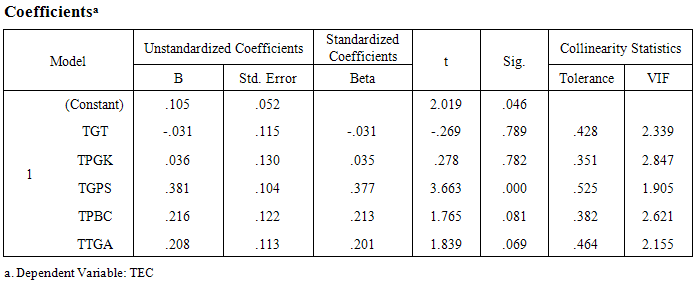 Step 3: Mà Y
Step 3: Mà Y Step 4: X, M à Y
Step 4: X, M à Y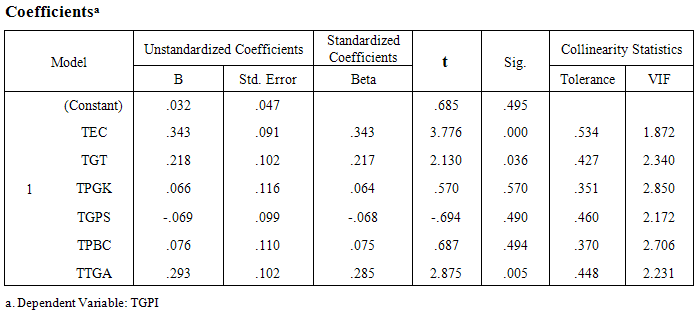
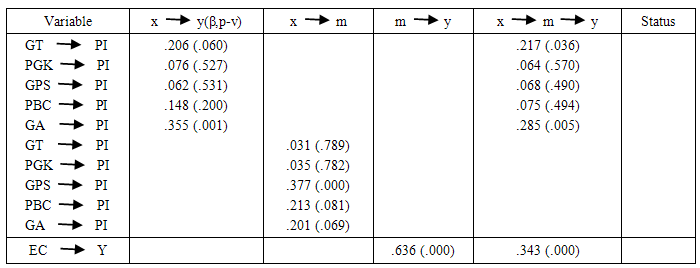
 Abstract
Abstract Reference
Reference Full-Text PDF
Full-Text PDF Full-text HTML
Full-text HTML
